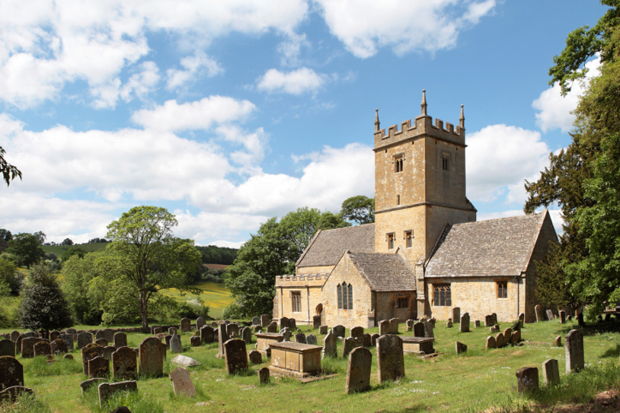Some of the longest job descriptions belong to rural Church of England clergy. ‘So what do you do?’ ‘I’m the Rector of Aldwincle, Clopton, Pilton, Stoke Doyle, Thorpe Achurch, Titchmarsh and Wadenhoe.’ Every one of these place names evokes an ancient Pevsner-worthy church, smelling of candlewax, damp hymn books and brass polish. Though many villages no longer have a shop or a pub, most do still have a parish church used for regular services — even if only on the first and third Sunday of the month. You push open the creaky door, and last Sunday’s hymns are still up on the hymn board.
Last week the brilliant blind member of the House of Laity John Spence (whose mesmerising speech in the final debate on women bishops swayed the vote towards ‘yes’) warned that the Church could be ‘eliminated’ from rural areas in ten years’ time. ‘If you look at [the] arithmetic projection you identify that, over the period 2007 to 2057, church attendance and membership would fall from 1.2 million on a regular basis to something like two or three hundred thousand.’
Can the current situation go on, in our 10,000 rural churches? Tiny congregations, with few people under 70; overworked clergy racing from church to church, having no time to chat to parishioners after each service, worn down by having six Grade I churches to look after, underpaid or not paid at all and at a loss as to how to make more people come to their Family Communion?
The truth of the daily struggle was revealed to me by the Revd Jo Saunders, rector of Great Casterton, Little Casterton, Pickworth and Tickencote in Rutland. When I rang her, she was applying for a grant to mend the heating system in her smallest and poorest church. ‘It will only cost £600, but that’s more than we’ve got. I worry all the time. I simply can’t physically do everything.’ Tickencote only has services in the summer months. The average attendance is six. ‘We’d keep it going till the last one disappears.’ She was proud to tell me that two new families had moved in to Pickworth, which had doubled the congregation to 12.
It’s odd: we see from the stark statistics that attendance numbers are in decline, but I have yet to talk to a single clergyperson who admits that numbers are going down in his or her parish or benefice. Vicars express concern about the general picture but the problem always seems to be in somebody else’s parish. They’re certainly good at presenting their own attendance figures in an optimistic light. Canon Jim Mynors, rector of the seven parishes near Oundle named above, told me, ‘The total population of our seven parishes is 1,400. Over the Christmas period we have 1,300 attending our churches: that’s almost the whole population.’ Michael Hampson, vicar of Hornby, Whittington, Arkholme and Gressingham in Lancashire, said, ‘Our numbers are steady and even creeping up.’
‘Do new 70-year-olds come when the old ones die?’ I asked him.
‘They do,’ he said, and gave me another statistic. ‘Remember: in rural ministry you get 10 per cent of the population coming to church. In urban ministry it’s only 1 per cent.’
Take that, you townies! There seems to be a vigorous rural-versus-urban rivalry going on in the C of E. A report published last week, called ‘Released for Mission: Growing the Rural Church’, tells us (amid endless deadening abstract nouns, e.g. ‘Congregations are empowered to take ownership of their own collective life through worship, mission and outreach’) that while 29 per cent of urban parishes are declining, only 25 per cent of rural ones are.
There’s a feeling in rural parishes that the Church is run on an urban model by urban people from Church House. Part of the way of dealing with urban decline has been to close churches. But the rural clergy believe that while this might work in towns (because there will be an open church nearby), in rural areas closing churches doesn’t work. People feel attached to their villages, and while they’ll happily drive five miles to a supermarket, they’re reluctant to do the same to go to a church service in someone else’s village.
If you can stay awake to disentangle that sentence about mission and outreach, you get to the gist of what the report is saying: that the only way to make it all work in rural benefices is for the congregation to be an essential part of the ministry. ‘The role of the priest is to support the ministry of the Church, not to do it.’ The idea is that everyone who is baptised has the commission to go out and share the Good News. In other words, the Church needs free labour, and lots of it, if the treasured tradition of regular worship in tiny parish churches is to continue.
An extinct village church gives out a strong message that the Church is dead. Michael Hampson told me that in his group of Lancashire parishes, one of the churches was closed and sold off, and it’s now owned ‘by a rich playboy who’s letting it fall down’. There is something creepy about churches turned into houses: marital sex in the belfry and a graveyard for a garden, let alone the windows all being at the wrong height. As Canon Mark Roberts, Rector of Sandwich, says, ‘For our generation to be the one that cuts the chain going back to the early centuries of the Christian faith would be shameful.’
The Canon Chancellor of Exeter Cathedral, Anna Norman Walker, has had another idea, and one that is now being talked about: struggling churches could avoid closure by signing up to become ‘Festival Churches’. The village would pay for the upkeep of the church in exchange for having it as a usable community building; but at church festivals (Christmas, Harvest, Mothering Sunday, Easter) it would be open for services. Details will need to be discussed, but this suggestion at least faces up to the fact that most of us are now occasional rather than regular attenders.
Linda Woodhead, professor of the sociology of religion at Lancaster University, conducted a recent survey asking clergy and laity the question ‘What does the C of E offer?’ The top clergy answer was ‘it’s at the heart of local communities’; the top laity answer was ‘culture and heritage’. This suggests a mismatch between clergy and lay expectations. The laity are hungry for the numinous.
Many rural parish services are dispiritingly prosaic. The parish communion (which only came into fashion in the 1950s) seems to have swollen to over an hour and a quarter. It’s time to cut the padding — even the sermon. There’s no need to give out the parish notices about the mums and toddlers group when they’re already written on the sheet. It breaks the spell. Don’t dumb down. Call it ‘a confirmation class’, not ‘Teenage Central’. We go to church in search of a brief but intense dose of holiness, beauty and devotion. If the Church gave us more of that, could its decline be halted?
Got something to add? Join the discussion and comment below.
Get 10 issues for just $10
Subscribe to The Spectator Australia today for the next 10 magazine issues, plus full online access, for just $10.
You might disagree with half of it, but you’ll enjoy reading all of it. Try your first month for free, then just $2 a week for the remainder of your first year.














Comments
Don't miss out
Join the conversation with other Spectator Australia readers. Subscribe to leave a comment.
SUBSCRIBEAlready a subscriber? Log in